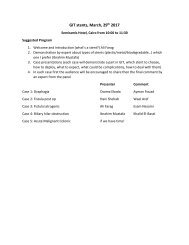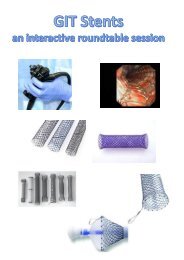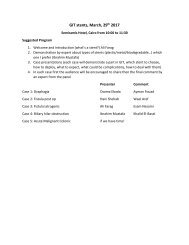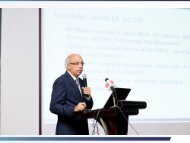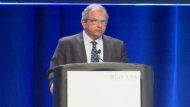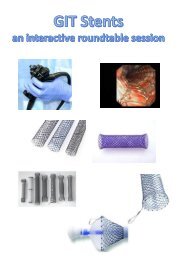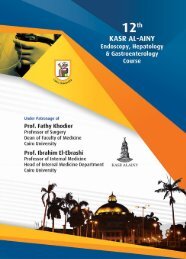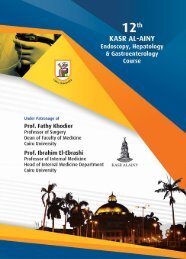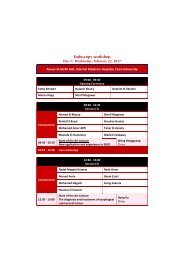What’s New in Hepatology?
Prof. Sherif Mogawer
Prof. Sherif Mogawer
Create successful ePaper yourself
Turn your PDF publications into a flip-book with our unique Google optimized e-Paper software.
<strong>What’s</strong> <strong>New</strong> <strong>in</strong><br />
<strong>Hepatology</strong><br />
By<br />
Prof. Sherif Mogawer<br />
Cairo University
NAFLD 30%<br />
Virus 30%<br />
Alcohol 30%<br />
Others 10%<br />
Compensated C<br />
Decompansated C<br />
Encephalopathy<br />
Infections / Bleed<strong>in</strong>g<br />
Ascites / Jaundice<br />
50% <strong>in</strong> 5y 50% <strong>in</strong> 5y<br />
Death<br />
Liver Cancer
Hepatitis
HCV<br />
- Can be cured<br />
- Cured associated with disease<br />
reversion<br />
- Debatable po<strong>in</strong>ts <strong>in</strong> follow up of cured<br />
HCV
Disease Reversion & Po<strong>in</strong>t<br />
of no Return<br />
(Van de Meer & Berengeuer J Hepat 2016)
• 53 Chronic HCV naïve Egyptian patients<br />
were treated <strong>in</strong> outpatient cl<strong>in</strong>ic with<br />
Sofosbuvir 400 mg + Daclatasvir 60 mg +<br />
weight based Ribavir<strong>in</strong> for 12 weeks<br />
• 44% were male with average age 48y, 56 %<br />
were female with average age 44 y.<br />
• Patients were followed at 12 & 24 weeks<br />
follow<strong>in</strong>g end of treatment
• Fib 4: - 15 Patients were > 3.2 (F3-4)<br />
- 38 patients were > 1.4 &
Cure Associated Benefits
3.1<br />
0 12 w
Eradication of HCV can result <strong>in</strong><br />
real benefits<br />
(Belli et al., J <strong>Hepatology</strong> 2016)
Fibrosis Regression among<br />
Patients Achiev<strong>in</strong>g SVR<br />
- 100 Patients followed twice/year with<br />
Fibroscan for 2.5-3 years<br />
- 82% of patients received DAAs, 45% Sofobased<br />
therapy<br />
- Overall Improvement <strong>in</strong> 60% of<br />
patients achiev<strong>in</strong>g SVR<br />
(Crissien et al., Abstract 108, AASLD 2015)
Improvement of Liver stiffness<br />
values by successful INF-Free<br />
Regimen: “Fibroscan”<br />
(Deterd<strong>in</strong>g et al., Aliment Pharacol Therap 2016)
MELD Changes dur<strong>in</strong>g INFfree<br />
treatment & Follow up
SOLAR 2 study Ledi/Sofo/Riba<br />
MELD changes from basel<strong>in</strong>e to F.U 4<br />
(Manns et al., Lancet Inf. Dis 2016)
Improvement of MELD score from<br />
basel<strong>in</strong>e to F.U 12<br />
(Child B/C) n = 31<br />
Po<strong>in</strong>t of no return<br />
Future research<br />
No=7<br />
- 8 - 7 - 6 - 5 - 4 - 3 - 2 - 1 0 1 2<br />
Includ<strong>in</strong>g relapse patients documented at the time po<strong>in</strong>t of<br />
relapse<br />
(Deterd<strong>in</strong>g et al., Aliment Pharacol Therap 2015)
Sofo & Valpatsvir (ASTRAL 4 Study)<br />
Improvement <strong>in</strong> MELD <strong>in</strong><br />
Decompansated Cirrhosis Patients<br />
(Curry et al., N Engl J. Med 2015)
HCC is Left as a debatable<br />
Po<strong>in</strong>t
HCC Development<br />
Risk of HCC dur<strong>in</strong>g INF-free<br />
Therapy of HCV Infection<br />
Untreated<br />
De novo HCC vs. HCC Recurrence<br />
INF-Free Therapy
HCC Recurrence<br />
307 Patients treated for HCC occurr<strong>in</strong>g <strong>in</strong> 14,379<br />
patients with past or active HCV<br />
40 patients with progressive<br />
or early recurrence of HCC<br />
267 Patients with history of<br />
treatment for HCC<br />
DAA group<br />
N= 189<br />
Untreated group<br />
N = 780<br />
Recurrence 16<br />
8.4%<br />
No recurrence 165<br />
Recurrence 16<br />
20%<br />
No recurrence<br />
62<br />
(Pol S et al., J Hepatol 2016)
De novo HCC 3-5%<br />
Unexpected high rate of Recurrence 8%<br />
“HCC developed after a median of 3.5<br />
months”<br />
(Reig et al., J Hepaol 2016)
Does Eradication of HCV <strong>in</strong>crease<br />
the risk of HCC<br />
Yes…..
(J of <strong>Hepatology</strong> 2016)
NO……<br />
(J of <strong>Hepatology</strong> 2016)
HEV
HEV<br />
- Becom<strong>in</strong>g a well recognized cause of<br />
acute hepatitis<br />
- Transmission from human to human by<br />
both feco-roal & parenteral routes<br />
- From animal to human
Emerg<strong>in</strong>g Epidemic of HEV<br />
(Adlhoch et al., J of Virology 2016)
HBV<br />
Strategies to develop cure
Aim<strong>in</strong>g for Cure <strong>in</strong> HBV & HDV<br />
Infections
Different Anti-HBV Drugs <strong>in</strong><br />
Different Phases
NASH
NASH<br />
• Fibrosis is the determ<strong>in</strong>ant factor of<br />
mortality <strong>in</strong> NAFLD<br />
• Over-weight children are most likely to<br />
develop NAFLD<br />
• How to achieve an accurate diagnosis.<br />
• Cl<strong>in</strong>ical trials & therapeutic targets<br />
• Obeticholic acid succeeded <strong>in</strong> phase 2b<br />
studies
Fibrosis Stage is the Ma<strong>in</strong> Predictor for<br />
Disease Specific Mortality<br />
2<br />
(Mattias Ekstedi, <strong>Hepatology</strong> 2015)
Overweight <strong>in</strong> Late Adolescence<br />
Predicts development of severe liver<br />
disease later <strong>in</strong> life: A 39 years follow<br />
up Study<br />
(Hannes Hagstrom et al., J Hepatol 2016)
MRI & MRE for Non-<strong>in</strong>vasive Quantitative<br />
Assessment of Hepatic Steatosis & Fibrosis <strong>in</strong><br />
NAFLD & NASH: Cl<strong>in</strong>ical trials to Cl<strong>in</strong>ical<br />
Practice<br />
(Parambir S. Dulai et al., J Hepatol 2016)
Farnesoid X nuclear receptor Ligand Obeticholic<br />
acid for non-Cirrhotic, NASH (FLINT): a<br />
multicenter, randomized, placebo-controlled trial<br />
(Lancet 2016)
Primary Biliary Cholangitis
Primary Biliary Cholangitis<br />
• Primary biliary cirrhosis changes name to<br />
Primary Biliary Cholangitis<br />
• Obeticholic acid meets primary end po<strong>in</strong>t<br />
<strong>in</strong> phase 2b studies & is approved
A Placebo Controlled Trial of<br />
Obeticholic acid <strong>in</strong> Primary Biliary<br />
Cholangitis<br />
(<strong>New</strong> Engl J Med 2016)
Alcoholic Liver Disease
Alcoholic Liver Disease<br />
• Genetic signature of patients likely to<br />
develop alcoholic cirrhosis discovered
Identification of gene signature<br />
determ<strong>in</strong><strong>in</strong>g risk of development of<br />
alcoholic cirrhosis<br />
• Why only a small<br />
proportion of patients<br />
that abuse alcohol<br />
develop cirrhosis?<br />
• A genome wide<br />
association study<br />
confirms PNPLA3<br />
,TM6SF2 and MBOAT7<br />
as risk loci for alcoholrelated<br />
cirrhosis<br />
(Buch et al., Nature Genetics 2015)
Cirrhosis
Cirrhosis<br />
• Established diagnostic & Prognostic<br />
criteria of acute on top of chronic liver<br />
failure<br />
• CLIF score validation<br />
• Utilization of CLIF score for risk<br />
stratification of patients with acute<br />
deterioration
Acute on Chronic Liver Failure<br />
(Jalan et al., Gastro 2014)
What is the Prognosis of<br />
Individual Patients
How Can We Use the Score to help<br />
patient Management?<br />
Admission of cirrhotic patient with acute decompansation<br />
Assess CLIF Score for diagnosis of ACLF<br />
ACLF Present<br />
CLIF-C ACLF Score (0-100)<br />
ACLF Absent<br />
CLIF-C AD Score (0-100)<br />
CLIF AD score<br />
≥ 60 High Risk<br />
CLIF AD score>45
Hepatocellular Carc<strong>in</strong>oma
Hepatocellular Carc<strong>in</strong>oma<br />
• Regorafenib: a new therapy for HCC<br />
• HCC after HCV recurrence: a grow<strong>in</strong>g<br />
concern & controversy
<strong>New</strong> Therapies for HCC
Resorce Trial for HCC<br />
(Bruix et al., ECOS abstract 2016)
• 573 patients (BCLC) B or C randomized<br />
from 21 countries<br />
• On sorafenib ≥400 mg/day ≥20 days.<br />
• Documented radiological progression.<br />
• The primary endpo<strong>in</strong>t was overall survival<br />
(OS) was analyzed by <strong>in</strong>tent-to-treat.
Death & Progression risk<br />
• Regorafenib showed a 38% reduction <strong>in</strong><br />
death risk and a 54% reduction <strong>in</strong><br />
progression risk compared to placebo.<br />
Median time to progression<br />
• 3.1 months with Regorafenib and 1.5<br />
months with placebo<br />
Overall survival<br />
• Median overall survival was 10.6 months<br />
for Regorafenib and 7.8 months with<br />
placebo.
The Microbiome<br />
• The microbiome may dictate effects on<br />
liver <strong>in</strong>jury
Alteration of human gut<br />
microbiome <strong>in</strong> liver cirrhosis<br />
(Nature 2014)
How will you Elim<strong>in</strong>ate the Virus?<br />
(Feld and Foster J. Hepatol 2016)
Progression of patients with acute on<br />
chronic liver failure: a prospective cohort<br />
study<br />
(Critical care 2012)




